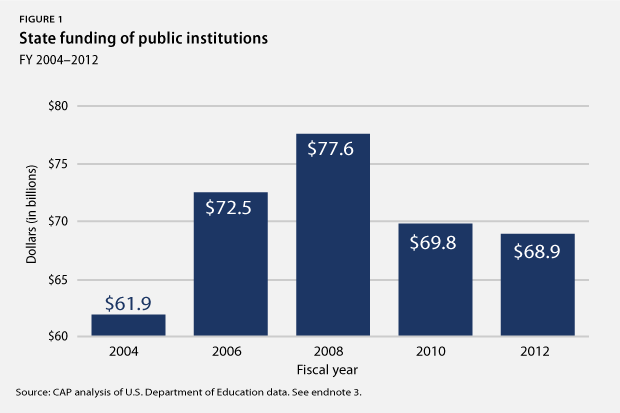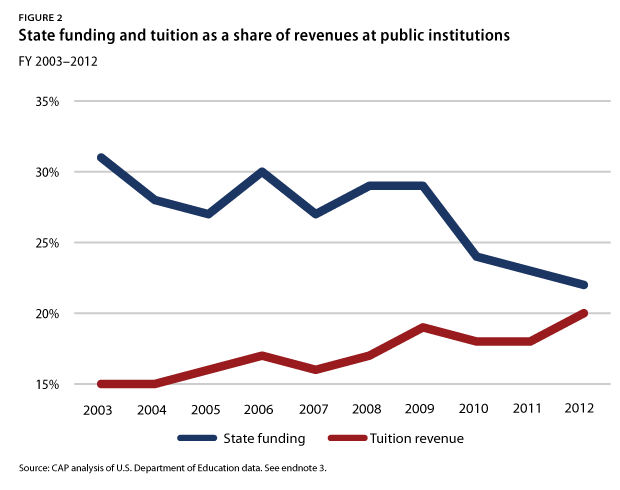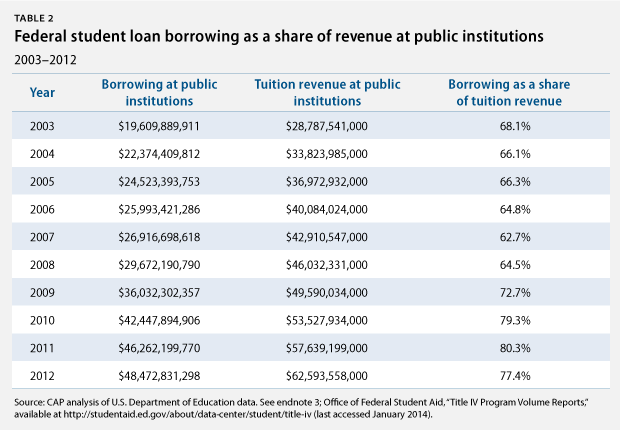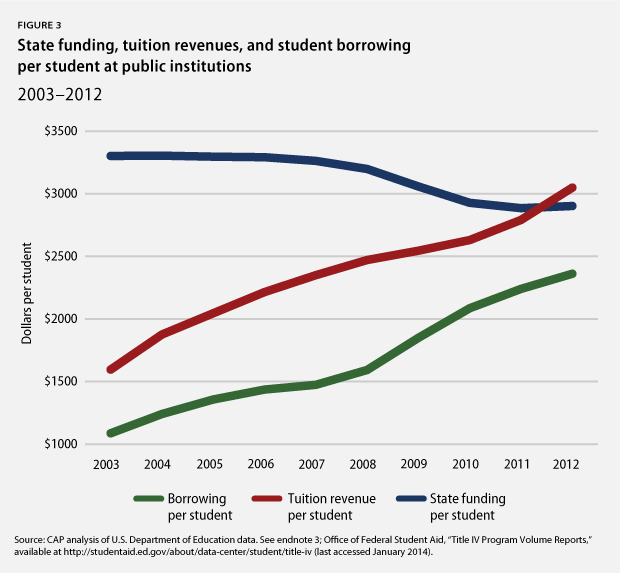Access to affordable, high-quality postsecondary education has become essential for full participation in our economy. But rising costs are impeding many students’ ability to achieve postsecondary success. One important change over the past decade has been the steep decline in state appropriations and financial support for public universities, colleges, and training centers, in which approximately 70 percent of all higher-education students are enrolled. These public institutions have long served as one of the key levers to broaden economic mobility.
Without state investment, tuition prices increase more quickly than family incomes, and as a result, many students are forced to take out more loans. Federal loans are available to cover the cost of most public institutions, but the more loan debt our students carry, the less flexibility they have to participate in the economy after they complete their education. If the federal government were to boost state reinvestment in postsecondary education, students attending public colleges could significantly reduce or eliminate their loan burden.
In this issue brief, we explore the effects of state disinvestment on public colleges and universities and propose a plan to jumpstart reinvestment for the next generation of students that uses the purchasing power of the federal government to incentivize state action.
State investment in postsecondary education
As state governments have faced tight budget constraints over the past decade, struggling to respond to the Great Recession, public institutions have become increasingly dependent on student tuition revenues—often financed with federal student loans—rather than public investments.
Historically, public colleges and universities have received significant support from state governments to finance their programs. This support often takes the form of operating revenues, including state grants and contracts, as well as non-operating revenues such as state appropriations and grants. The goal of these investments has been to provide a publicly supported, affordable, high-quality education to American citizens.
Collectively, these institutions serve nearly three-quarters of all American postsecondary students at 705 four-year colleges and universities, 1,055 two-year community colleges, and 257 less-than-two-year technical colleges and career centers. In addition to enrolling many students from low- and middle-income families, public colleges and universities play a critical role in preparing students from racial and ethnic minorities for 21st-century careers.
Each year, the Department of Education catalogues financial statistics of postsecondary education institutions that participate in Title IV federal student-aid programs. A review of these reports documents the decline in state investments in public institutions over the past 10 years. A Center for American Progress analysis demonstrates that after reaching a peak of $77.6 billion in fiscal year 2008, state funding for public institutions fell to $68.9 billion in FY 2012, the most recent year for which data are available.

When measured as a share of total revenues, the decline in state funding is even more pronounced. In FY 2003, state funding accounted for 31 percent of total revenue at public institutions, the high point over the 10-year period we examined. This level has declined steadily since, with state investment reaching 22.3 percent of revenues in FY 2012.

At the same time, public institutions have increasingly relied on tuition dollars for revenue, transferring the financial burden to individual students and their families. In FY 2003, tuition and fee revenue accounted for 14.9 percent of all revenue at public institutions. This share has increased each year, reaching 20.3 percent in FY 2012. The figure below illustrates the trends for these two key funding elements.

The decline in state support for public colleges and universities, as well as the increased reliance on tuition dollars, has tracked with an increase in borrowing among students enrolled in these institutions. The Department of Education releases data quarterly that list the volume of disbursed loans by loan program and type of institution. These reports demonstrate that student borrowing more than doubled over the previous decade. In total, students attending public universities, colleges, and career training centers borrowed $19.6 billion during the 2002-03 school year; that amount rose to $48.5 billion by the 2011-12 school year.
Examining the combined impact of the increase in public institutions’ reliance on tuition and fee revenue and the increase in student borrowing illustrates that the share of tuition financed with federal loans is also growing. In 2003, 68 percent of tuition dollars at public institutions were funded through federal student-loan borrowing; by 2012, that share rose to 77 percent.

Finally, we can see that the investment in support for public colleges and universities has actually fallen below tuition revenue on a per-student basis, and borrowing on a per-student basis is closely following this trend.

Reinvesting in postsecondary education using federal incentives
As part of his efforts to reign in the cost of postsecondary education, President Barack Obama has called for a “Race to the Top for College Affordability and Completion.” Building off of his effort, our proposal will describe how to direct state improvements to benefit students and taxpayers. In order to encourage states to reinvest in public higher education, we call on Congress to use the purchasing power of the federal government to stimulate state reinvestment in public institutions. The federal government would create a competitive grant program, matched with state funds, to significantly lower the cost of public postsecondary education and, in some cases, make it free. This program would ensure that students from the neediest families have a commitment that public postsecondary education will be affordable through a combination of Pell Grants, state funds, and federal matching grants for low-income students who enroll in college preparatory high school programs. It would build upon the strength of the federal Pell Grant program, which provides aid that does not have to be repaid to students from low-income families and adults returning to school who are struggling in low-paying jobs. These matching funds would be used to incentivize state reinvestment in postsecondary education.
Under the competitive grant program, the federal government would provide funds to any state that can demonstrate it would dedicate them to higher education and agree to implement key reforms that ensure students have access to affordable and high-quality public institutions. States that participate in the program would commit to keeping tuition increases to a minimum and in line with the rate of inflation. The federal investment would include a dedicated, multiyear revenue stream to promote continuity of these reforms. Federal resources used to lower the costs for students enrolled at public institutions would supplement the existing Pell Grant program, which would itself remain intact.
Public College Quality Compact with students and taxpayers
In order to be eligible for a federal matching grant, states must agree to implement reforms and innovations that increase the value of public colleges, universities, and training centers for students. The goal of these reforms will be to improve the quality of programs and promote affordability. This basket of reforms will be known as the Public College Quality Compact, and it will help students and families understand the guidance and support they can expect from the public institutions at which they are enrolled to best realize success.
The compact will require states to:
- Promise students from low-income families that public postsecondary education will be affordable. In order to boost college enrollment among low-income students, this program will help them prepare for and plan to pursue higher education by reaching out earlier in the K-12 education cycle and ensuring they are enrolled in classes that prepare them for college. Students who pursue an associate’s or bachelor’s degree would receive grant aid from the state, federal Pell Grants, and federal matching grants to cover their enrollment at public institutions. For example, program eligibility could be determined by identifying students who participate in free or reduced lunch programs under the National School Lunch Act or the Child Nutrition Act, or students who are enrolled in schools that receive funding under Title I of the Elementary and Secondary Education Act.
- Develop a plan for creating sustainable funding streams for public institutions. In order to preserve the stability and reliability of state-level investment so that students and prospective students can prepare for and enroll in postsecondary education with certainty, states must create a plan that will outline a dedicated funding stream for the program. This will insulate the investment in public institutions from year-to-year budget changes and cyclical economic patterns.
- Implement strategies that have proven successful in improving performance. Postsecondary education is transformative because it has the potential to improve graduates’ employability in the global economy and advance our national competitiveness. In order to ensure that this promised value materializes for students, institutions must work to improve their quality by raising graduation rates and measuring the economic outcomes of their graduates. Among the strategies that states could adopt are those advanced by Complete College America, which include performance-based funding that measures student success across key metrics, the promotion of college-level courses with support as the default enrollment status for more students, and guided pathways to success to ensure students pursue a thought-out program of study.
- Eliminate state and institutional policies that stand in the way of college completion.
- Standardize transfer credit and admissions requirements, which would make it easier for students to operate within the postsecondary system and smooth the way for greater degree attainment. Congress should mandate that, as a requirement for participating in the compact, states generate articulation agreements to ensure students can transfer earned credits reliably and easily among public institutions, as well as standardize admissions criteria to smooth progress between institutions.
- Raise high school learning standards to conform with postsecondary institutions’ academic material. Congress should mandate that participating states align high school graduation requirements with public postsecondary institutions’ admissions criteria to ensure that students are able to tackle college-level academic material and complete their credentials in a normal amount of time. States should ensure that rigorous K-12 education standards are aligned with college readiness. For example, they could adopt the Common Core State Standards, which are aligned with what students need to know to access college-level courses. They could also audit their own standards to ensure alignment with college readiness. Finally, states should ensure all students have access to rigorous college preparation curricula in high school and that students’ readiness is assessed in the 10th grade so that, if necessary, they have time to catch up before graduation.
Conclusion
It is critically important to reverse the trend of state disinvestment in postsecondary education to ensure that students enrolled in public colleges face lower costs. Together, the three-legged stool of Pell Grants, state support, and federal matching funds would enable students with the greatest need to have access to education without debt, broadening their economic and social mobility. For this reason, it is critical that Congress move quickly to jumpstart investments in students.
Elizabeth Baylor is the Associate Director for Postsecondary Education at the Center for American Progress. David A. Bergeron is the Vice President for Postsecondary Education at the Center.